10.0 Sentinel规则持久化方案
Sentinel规则持久化
一、Sentinel规则推送模式
| 推送模式 | 说明 | 优点 | 缺点 |
|---|---|---|---|
| 原始模式 | API 将规则推送至客户端并直接更新到内存中,扩展写数据源(WritableDataSource) | 简单,无任何依赖 | 不保证一致性;规则保存在内存中,重启即消失。严重不建议用于生产环境 |
| Pull 模式 | 扩展写数据源(WritableDataSource), 客户端主动向某个规则管理中心定期轮询拉取规则,这个规则中心可以是 RDBMS、文件等 | 简单,无任何依赖;规则持久化 | 不保证一致性;实时性不保证,拉取过于频繁也可能会有性能问题。 |
| Push 模式 | 扩展读数据源(ReadableDataSource),规则中心统一推送,客户端通过注册监听器的方式时刻监听变化,比如使用 Nacos、Zookeeper 等配置中心。这种方式有更好的实时性和一致性保证。生产环境下一般采用 push 模式的数据源。 | 规则持久化;一致性;快速 | 引入第三方依赖 |
1.1 原始模式
如果不做任何修改,Dashboard 的推送规则方式是通过 API 将规则推送至客户端并直接更新到内存中:
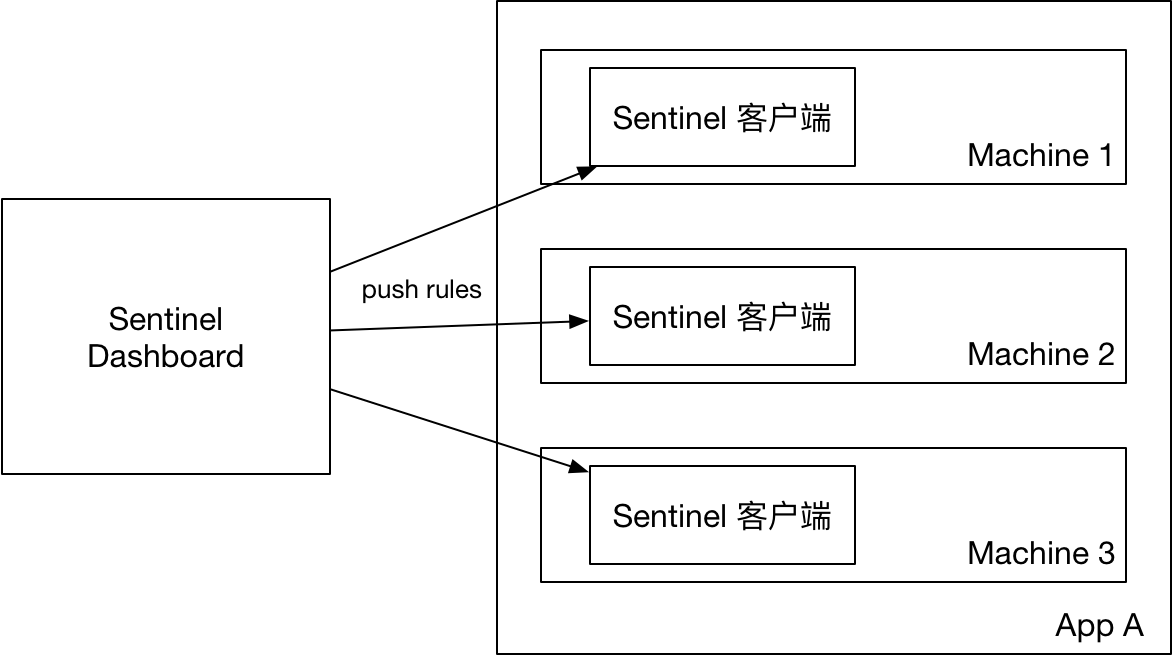
这种做法的好处是简单,无依赖;坏处是应用重启规则就会消失,仅用于简单测试,不能用于生产环境。
1.2 拉模式
pull 模式的数据源(如本地文件、RDBMS 等)一般是可写入的。使用时需要在客户端注册数据源:将对应的读数据源注册至对应的 RuleManager,将写数据源注册至 transport 的 WritableDataSourceRegistry 中。
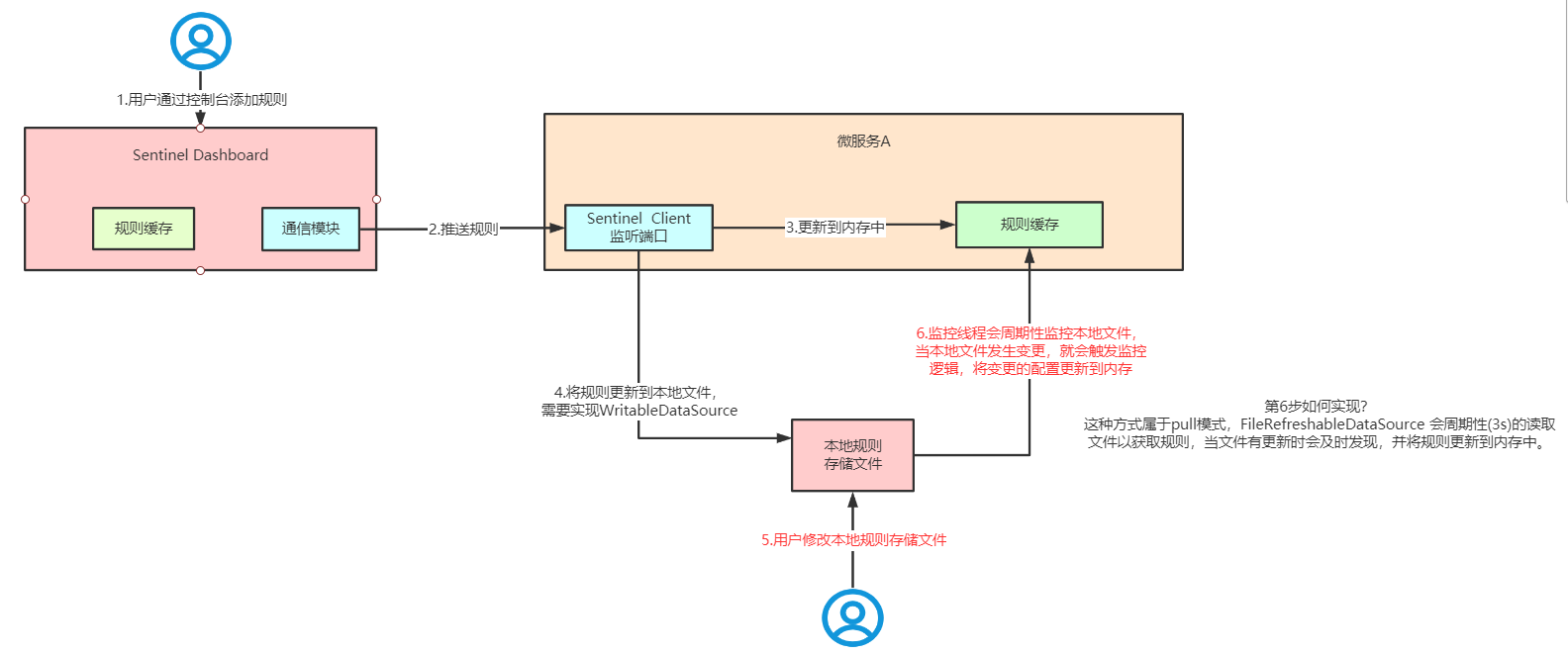
首先 Sentinel 控制台通过 API 将规则推送至客户端并更新到内存中,接着注册的写数据源会将新的规则保存到本地的文件中。使用 pull 模式的数据源时一般不需要对 Sentinel 控制台进行改造。这种实现方法好处是简单,坏处是无法保证监控数据的一致性。
官方demo: sentinel-demo/sentinel-demo-dynamic-file-rule
引入依赖
<dependency> <groupId>com.alibaba.csp</groupId> <artifactId>sentinel-datasource-extension</artifactId> <version>1.8.4</version> </dependency>
核心代码:
// FileRefreshableDataSource 会周期性的读取文件以获取规则,当文件有更新时会及时发现,并将规则更新到内存中。 ReadableDataSource<String, List<FlowRule>> ds = new FileRefreshableDataSource<>( flowRulePath, source -> JSON.parseObject(source, new TypeReference<List<FlowRule>>() {}) ); // 将可读数据源注册至 FlowRuleManager. FlowRuleManager.register2Property(ds.getProperty()); WritableDataSource<List<FlowRule>> wds = new FileWritableDataSource<>(flowRulePath, this::encodeJson); // 将可写数据源注册至 transport 模块的 WritableDataSourceRegistry 中. // 这样收到控制台推送的规则时,Sentinel 会先更新到内存,然后将规则写入到文件中. WritableDataSourceRegistry.registerFlowDataSource(wds);
1.3 拉模式改造
实现InitFunc接口,在init中处理DataSource初始化逻辑,并利用spi机制实现加载。

其中部分核心代码
public class FileDataSourceInit implements InitFunc { @Override public void init() throws Exception { //创建文件存储目录 RuleFileUtils.mkdirIfNotExits(PersistenceRuleConstant.storePath); //创建规则文件 RuleFileUtils.createFileIfNotExits(PersistenceRuleConstant.rulesMap); //处理流控规则逻辑 dealFlowRules(); // 处理降级规则 dealDegradeRules(); // 处理系统规则 dealSystemRules(); // 处理热点参数规则 dealParamFlowRules(); // 处理授权规则 dealAuthRules(); } private void dealFlowRules() throws FileNotFoundException { String ruleFilePath = PersistenceRuleConstant.rulesMap.get(PersistenceRuleConstant.FLOW_RULE_PATH).toString(); //创建流控规则的可读数据源 ReadableDataSource<String, List<FlowRule>> flowRuleRDS = new FileRefreshableDataSource( ruleFilePath, RuleListConverterUtils.flowRuleListParser ); // 将可读数据源注册至FlowRuleManager 这样当规则文件发生变化时,就会更新规则到内存 FlowRuleManager.register2Property(flowRuleRDS.getProperty()); WritableDataSource<List<FlowRule>> flowRuleWDS = new FileWritableDataSource<List<FlowRule>>( ruleFilePath, RuleListConverterUtils.flowFuleEnCoding ); // 将可写数据源注册至 transport 模块的 WritableDataSourceRegistry 中. // 这样收到控制台推送的规则时,Sentinel 会先更新到内存,然后将规则写入到文件中. WritableDataSourceRegistry.registerFlowDataSource(flowRuleWDS); } private void dealDegradeRules() throws FileNotFoundException { //讲解规则文件路径 String degradeRuleFilePath = PersistenceRuleConstant.rulesMap.get(PersistenceRuleConstant.DEGRAGE_RULE_PATH).toString(); //创建流控规则的可读数据源 ReadableDataSource<String, List<DegradeRule>> degradeRuleRDS = new FileRefreshableDataSource( degradeRuleFilePath, RuleListConverterUtils.degradeRuleListParse ); // 将可读数据源注册至FlowRuleManager 这样当规则文件发生变化时,就会更新规则到内存 DegradeRuleManager.register2Property(degradeRuleRDS.getProperty()); WritableDataSource<List<DegradeRule>> degradeRuleWDS = new FileWritableDataSource<>( degradeRuleFilePath, RuleListConverterUtils.degradeRuleEnCoding ); // 将可写数据源注册至 transport 模块的 WritableDataSourceRegistry 中. // 这样收到控制台推送的规则时,Sentinel 会先更新到内存,然后将规则写入到文件中. WritableDataSourceRegistry.registerDegradeDataSource(degradeRuleWDS); } private void dealSystemRules() throws FileNotFoundException { //讲解规则文件路径 String systemRuleFilePath = PersistenceRuleConstant.rulesMap.get(PersistenceRuleConstant.SYSTEM_RULE_PATH).toString(); //创建流控规则的可读数据源 ReadableDataSource<String, List<SystemRule>> systemRuleRDS = new FileRefreshableDataSource( systemRuleFilePath, RuleListConverterUtils.sysRuleListParse ); // 将可读数据源注册至FlowRuleManager 这样当规则文件发生变化时,就会更新规则到内存 SystemRuleManager.register2Property(systemRuleRDS.getProperty()); WritableDataSource<List<SystemRule>> systemRuleWDS = new FileWritableDataSource<>( systemRuleFilePath, RuleListConverterUtils.sysRuleEnCoding ); // 将可写数据源注册至 transport 模块的 WritableDataSourceRegistry 中. // 这样收到控制台推送的规则时,Sentinel 会先更新到内存,然后将规则写入到文件中. WritableDataSourceRegistry.registerSystemDataSource(systemRuleWDS); } private void dealParamFlowRules() throws FileNotFoundException { //讲解规则文件路径 String paramFlowRuleFilePath = PersistenceRuleConstant.rulesMap.get(PersistenceRuleConstant.HOT_PARAM_RULE).toString(); //创建流控规则的可读数据源 ReadableDataSource<String, List<ParamFlowRule>> paramFlowRuleRDS = new FileRefreshableDataSource( paramFlowRuleFilePath, RuleListConverterUtils.paramFlowRuleListParse ); // 将可读数据源注册至FlowRuleManager 这样当规则文件发生变化时,就会更新规则到内存 ParamFlowRuleManager.register2Property(paramFlowRuleRDS.getProperty()); WritableDataSource<List<ParamFlowRule>> paramFlowRuleWDS = new FileWritableDataSource<>( paramFlowRuleFilePath, RuleListConverterUtils.paramRuleEnCoding ); // 将可写数据源注册至 transport 模块的 WritableDataSourceRegistry 中. // 这样收到控制台推送的规则时,Sentinel 会先更新到内存,然后将规则写入到文件中. ModifyParamFlowRulesCommandHandler.setWritableDataSource(paramFlowRuleWDS); } private void dealAuthRules() throws FileNotFoundException { //讲解规则文件路径 String authFilePath = PersistenceRuleConstant.rulesMap.get(PersistenceRuleConstant.AUTH_RULE_PATH).toString(); //创建流控规则的可读数据源 ReadableDataSource<String, List<AuthorityRule>> authRuleRDS = new FileRefreshableDataSource( authFilePath, RuleListConverterUtils.authorityRuleParse ); // 将可读数据源注册至FlowRuleManager 这样当规则文件发生变化时,就会更新规则到内存 AuthorityRuleManager.register2Property(authRuleRDS.getProperty()); WritableDataSource<List<AuthorityRule>> authRuleWDS = new FileWritableDataSource<>( authFilePath, RuleListConverterUtils.authorityEncoding ); // 将可写数据源注册至 transport 模块的 WritableDataSourceRegistry 中. // 这样收到控制台推送的规则时,Sentinel 会先更新到内存,然后将规则写入到文件中. WritableDataSourceRegistry.registerAuthorityDataSource(authRuleWDS); } }
1.4 推模式
生产环境下一般更常用的是 push 模式的数据源。对于 push 模式的数据源,如远程配置中心(ZooKeeper, Nacos, Apollo等等),推送的操作不应由 Sentinel 客户端进行,而应该经控制台统一进行管理,直接进行推送,数据源仅负责获取配置中心推送的配置并更新到本地。因此推送规则正确做法应该是 配置中心控制台/Sentinel 控制台 → 配置中心 → Sentinel 数据源 → Sentinel,而不是经 Sentinel 数据源推送至配置中心。这样的流程就非常清晰了:
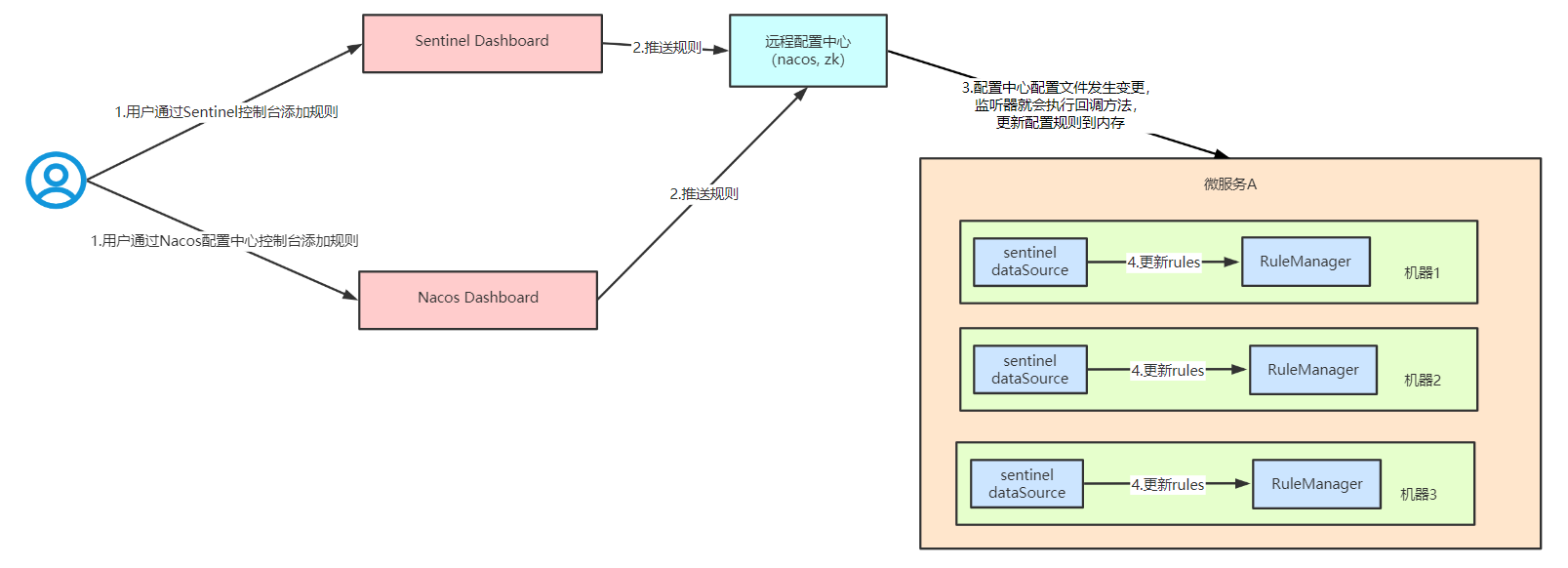
1.4.1 基于Nacos配置中心控制台实现推送
官方demo: sentinel-demo-nacos-datasource
引入依赖
<dependency> <groupId>com.alibaba.csp</groupId> <artifactId>sentinel-datasource-nacos</artifactId> <version>1.8.4</version> </dependency>
核心代码
// nacos server ip private static final String remoteAddress = "localhost:8848"; // nacos group private static final String groupId = "Sentinel:Demo"; // nacos dataId private static final String dataId = "com.alibaba.csp.sentinel.demo.flow.rule"; ReadableDataSource<String, List<FlowRule>> flowRuleDataSource = new NacosDataSource<>(remoteAddress, groupId, dataId,source -> JSON.parseObject(source, new TypeReference<List<FlowRule>>() {})); FlowRuleManager.register2Property(flowRuleDataSource.getProperty());
nacos配置中心中配置流控规则
[ { "resource": "TestResource", "controlBehavior": 0, "count": 10.0, "grade": 1, "limitApp": "default", "strategy": 0 } ]
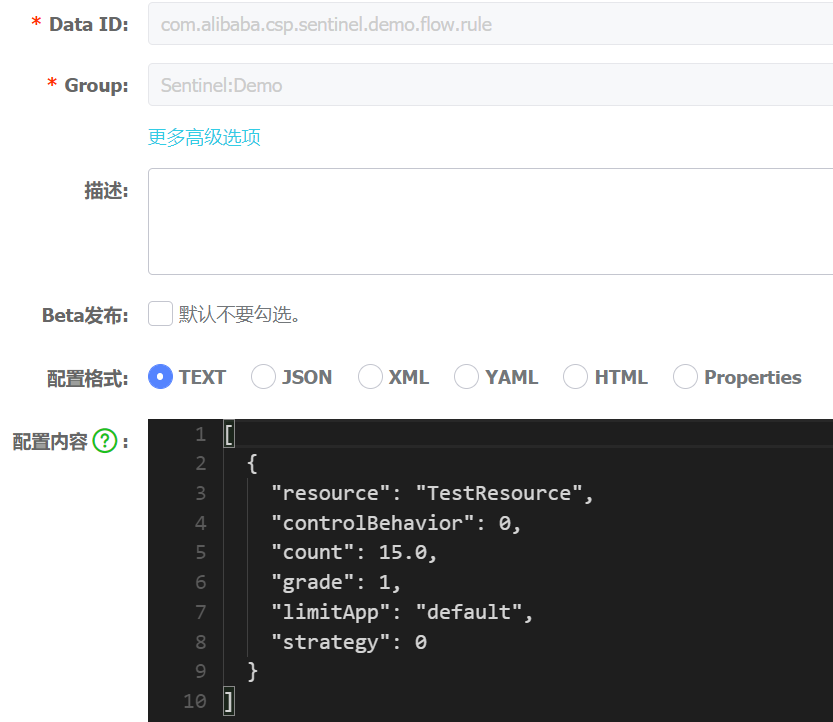
微服务中通过yml配置实现
SentinelProperties 内部提供了 TreeMap 类型的 datasource 属性用于配置数据源信息
1)引入依赖
<!--sentinel持久化 采用 Nacos 作为规则配置数据源--> <dependency> <groupId>com.alibaba.csp</groupId> <artifactId>sentinel-datasource-nacos</artifactId> </dependency>
2)yml中配置
spring: application: name: mall-user-sentinel-demo cloud: nacos: discovery: server-addr: 127.0.0.1:8848 sentinel: transport: # 添加sentinel的控制台地址 dashboard: 127.0.0.1:8080 # 指定应用与Sentinel控制台交互的端口,应用本地会起一个该端口占用的HttpServer port: 8719 datasource: ds1: nacos: server-addr: 127.0.0.1:8848 dataId: ${spring.application.name} groupId: DEFAULT_GROUP data-type: json rule-type: flow
源码参考com.alibaba.cloud.sentinel.datasource.config.AbstractDataSourceProperties#postRegister
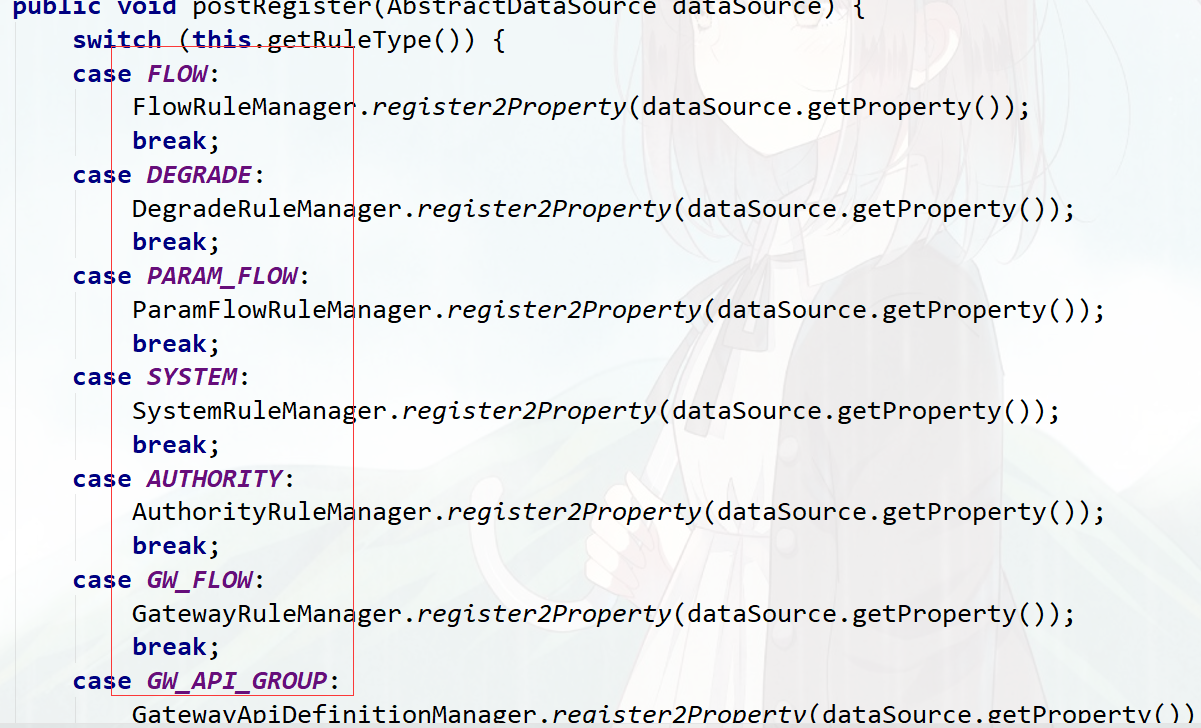
3)nacos配置中心中添加
[ { "resource": "userinfo", "limitApp": "default", "grade": 1, "count": 1, "strategy": 0, "controlBehavior": 0, "clusterMode": false } ]
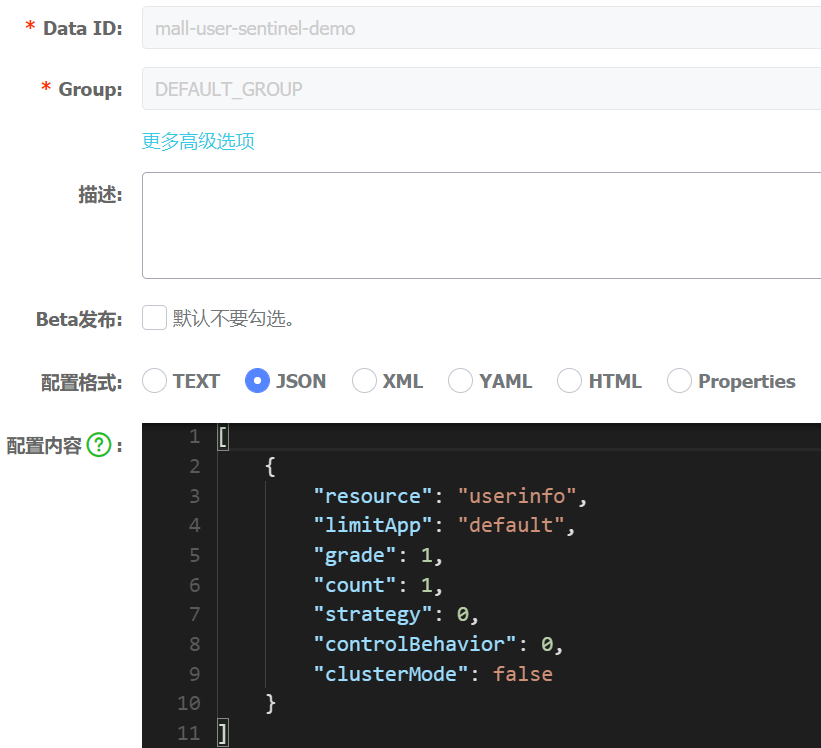
缺点:直接在Sentinel Dashboard中修改规则配置,配置中心的配置不会发生变化
思考: 如何实现将通过sentinel控制台设置的规则直接持久化到nacos配置中心?
扩展改造的思路:
- 思路一:微服务增加基于Nacos的写数据源(WritableDataSource),发布配置到nacos配置中心。
//核心逻辑: 实现WritableDataSource#write方法,发布配置到nacos配置中心 @Override public void write(T t) throws Exception { lock.lock(); try { configService.publishConfig(dataId, groupId, this.configEncoder.convert(t), ConfigType.JSON.getType()); } finally { lock.unlock(); } }
- 思路二:Sentinel Dashboard监听Nacos配置的变化,如发生变化就更新本地缓存。在Sentinel Dashboard端新增或修改规则配置在保存到内存的同时,直接发布配置到nacos配置中心;Sentinel Dashboard直接从nacos拉取所有的规则配置。Sentinel Dashboard和微服务不直接通信,而是通过nacos配置中心获取到配置的变更。
1.4.2 基于Sentinel控制台实现推送
从 Sentinel 1.4.0 开始,Sentinel 控制台提供 DynamicRulePublisher 和 DynamicRuleProvider 接口用于实现应用维度的规则推送和拉取:
- DynamicRuleProvider: 拉取规则
- DynamicRulePublisher: 推送规则
Sentinel Dashboard改造
第1步:在com.alibaba.csp.sentinel.dashboard.rule包下创建nacos包,然后把各种场景的配置规则拉取和推送的实现类写到此包下
可以参考Sentinel Dashboard test包下的流控规则拉取和推送的实现逻辑:
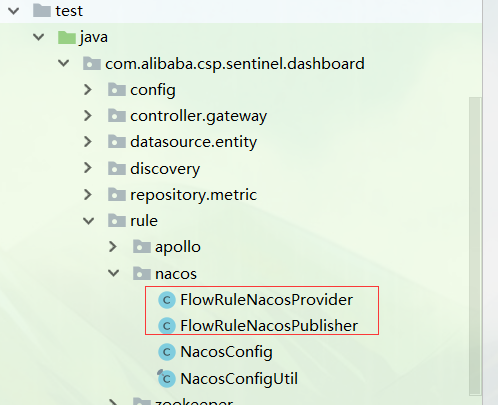
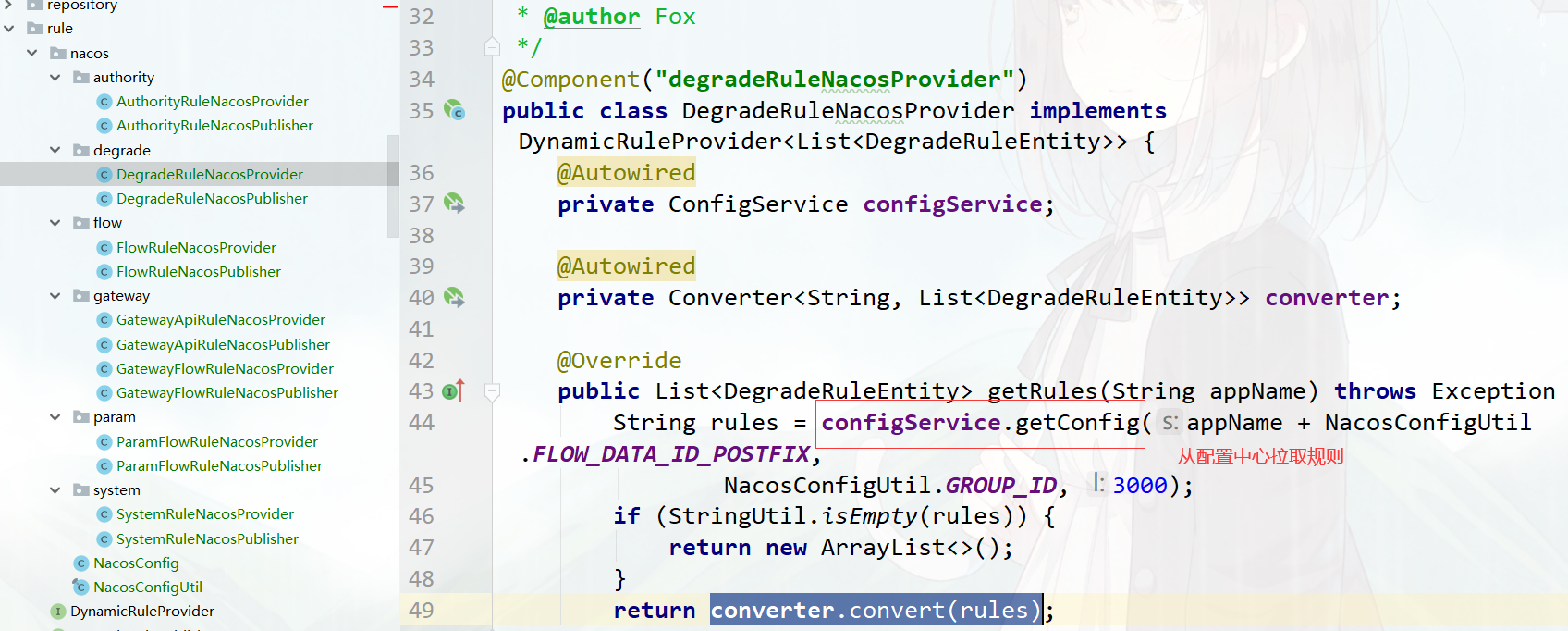
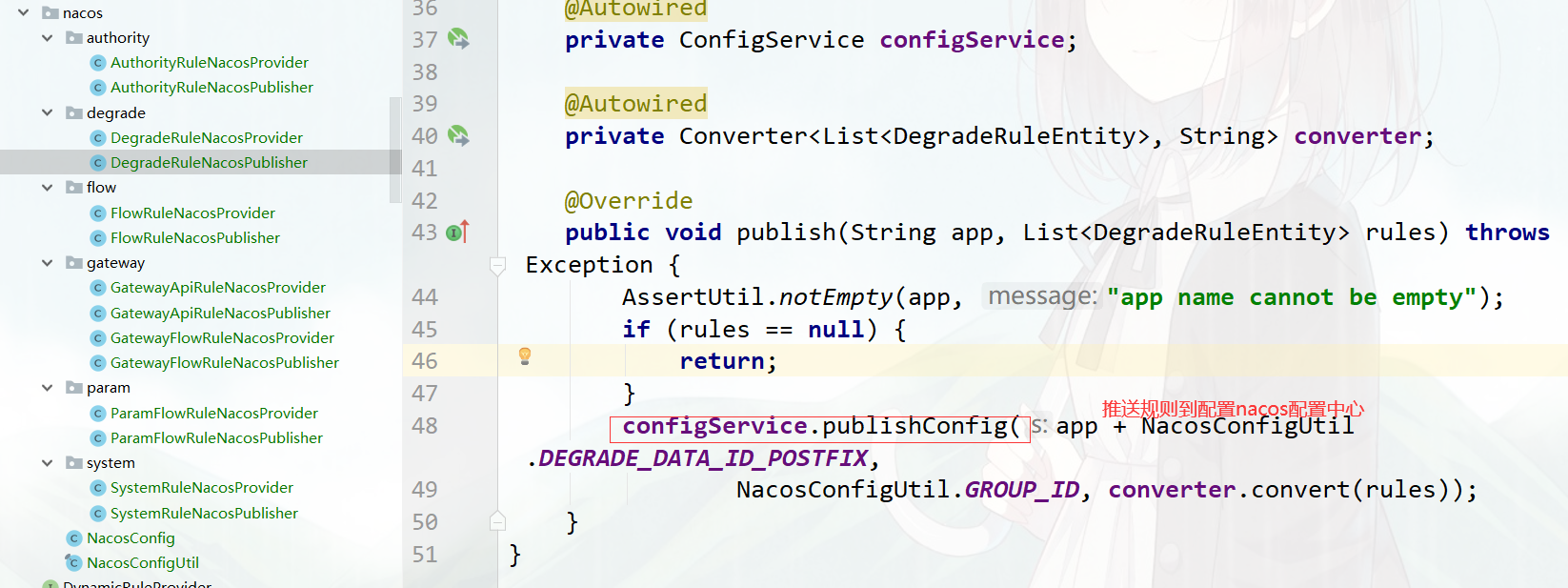
注意:微服务接入Sentinel client,yml配置需要匹配对应的规则后缀

第2步:进入com.alibaba.csp.sentinel.dashboard.controller包下修改对应的规则controller实现类
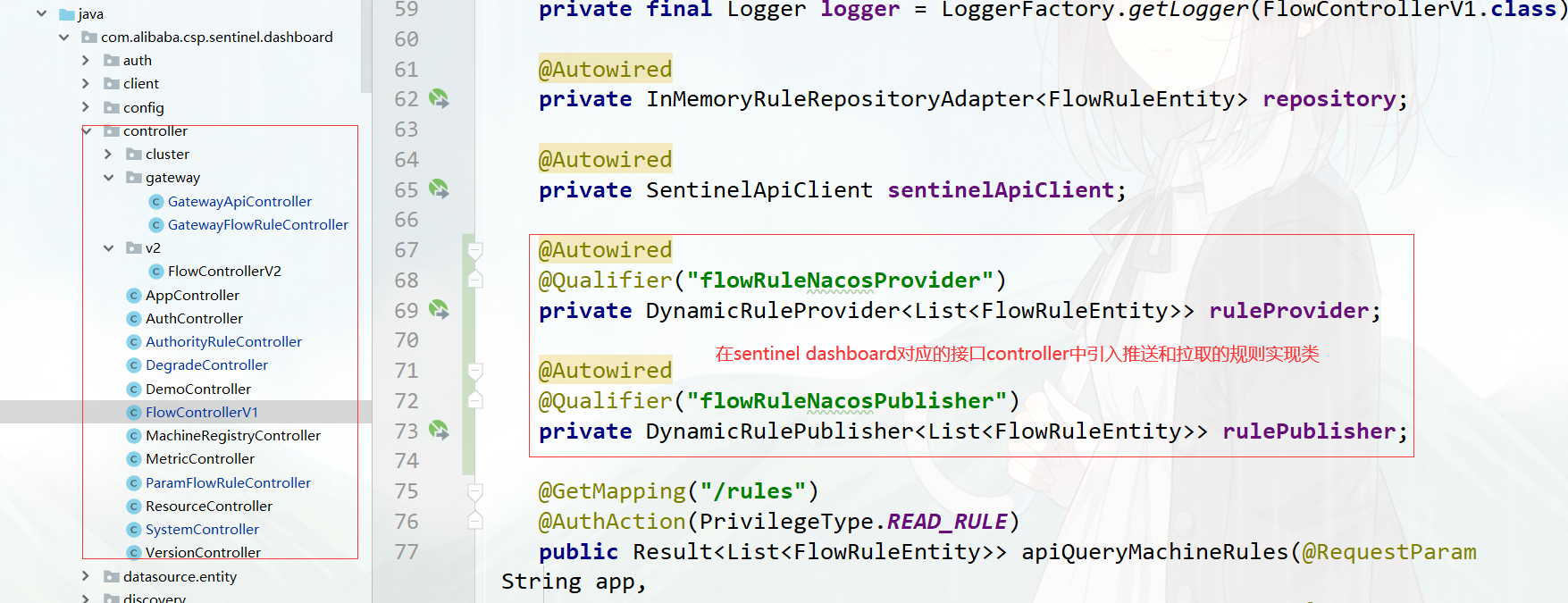
以流控规则为例,从Nacos配置中心获取所有的流控规则
@GetMapping("/rules") @AuthAction(PrivilegeType.READ_RULE) public Result<List<FlowRuleEntity>> apiQueryMachineRules(@RequestParam String app, @RequestParam String ip, @RequestParam Integer port) { if (StringUtil.isEmpty(app)) { return Result.ofFail(-1, "app can't be null or empty"); } if (StringUtil.isEmpty(ip)) { return Result.ofFail(-1, "ip can't be null or empty"); } if (port == null) { return Result.ofFail(-1, "port can't be null"); } try { // List<FlowRuleEntity> rules = sentinelApiClient.fetchFlowRuleOfMachine(app, ip, port); //从配置中心获取规则配置 List<FlowRuleEntity> rules = ruleProvider.getRules(app, ip, port); rules = repository.saveAll(rules); return Result.ofSuccess(rules); } catch (Throwable throwable) { logger.error("Error when querying flow rules", throwable); return Result.ofThrowable(-1, throwable); } }
新增流控规则,会推送到nacos配置中心
@PostMapping("/rule") @AuthAction(PrivilegeType.WRITE_RULE) public Result<FlowRuleEntity> apiAddFlowRule(@RequestBody FlowRuleEntity entity) { Result<FlowRuleEntity> checkResult = checkEntityInternal(entity); if (checkResult != null) { return checkResult; } entity.setId(null); Date date = new Date(); entity.setGmtCreate(date); entity.setGmtModified(date); entity.setLimitApp(entity.getLimitApp().trim()); entity.setResource(entity.getResource().trim()); try { entity = repository.save(entity); //publishRules(entity.getApp(), entity.getIp(), entity.getPort()).get(5000, TimeUnit.MILLISECONDS); //发布规则到配置中心 publishRules(entity.getApp()); return Result.ofSuccess(entity); } catch (Throwable t) { Throwable e = t instanceof ExecutionException ? t.getCause() : t; logger.error("Failed to add new flow rule, app={}, ip={}", entity.getApp(), entity.getIp(), e); return Result.ofFail(-1, e.getMessage()); } } /** * 发布到配置中心 * @param app * @throws Exception */ private void publishRules(/*@NonNull*/ String app) throws Exception { List<FlowRuleEntity> rules = repository.findAllByApp(app); rulePublisher.publish(app, rules); }
测试:微服务接入改造后的Sentinel Dashboard
引入依赖
<!--sentinel持久化 采用 Nacos 作为规则配置数据源--> <dependency> <groupId>com.alibaba.csp</groupId> <artifactId>sentinel-datasource-nacos</artifactId> </dependency>
增加yml配置
server: port: 8806 spring: application: name: mall-user-sentinel-rule-push-demo #微服务名称 #配置nacos注册中心地址 cloud: nacos: discovery: server-addr: 127.0.0.1:8848 sentinel: transport: # 添加sentinel的控制台地址 dashboard: 127.0.0.1:8080 # 指定应用与Sentinel控制台交互的端口,应用本地会起一个该端口占用的HttpServer #port: 8719 datasource: # ds1: #名称自定义,唯一 # nacos: # server-addr: 127.0.0.1:8848 # dataId: ${spring.application.name} # groupId: DEFAULT_GROUP # data-type: json # rule-type: flow flow-rules: nacos: server-addr: 127.0.0.1:8848 dataId: ${spring.application.name}-flow-rules groupId: SENTINEL_GROUP # 注意groupId对应Sentinel Dashboard中的定义 data-type: json rule-type: flow degrade-rules: nacos: server-addr: 127.0.0.1:8848 dataId: ${spring.application.name}-degrade-rules groupId: SENTINEL_GROUP data-type: json rule-type: degrade param-flow-rules: nacos: server-addr: 127.0.0.1:8848 dataId: ${spring.application.name}-param-flow-rules groupId: SENTINEL_GROUP data-type: json rule-type: param-flow authority-rules: nacos: server-addr: 127.0.0.1:8848 dataId: ${spring.application.name}-authority-rules groupId: SENTINEL_GROUP data-type: json rule-type: authority system-rules: nacos: server-addr: 127.0.0.1:8848 dataId: ${spring.application.name}-system-rules groupId: SENTINEL_GROUP data-type: json rule-type: system
以流控规则测试,当在sentinel dashboard配置了流控规则,会在nacos配置中心生成对应的配置。
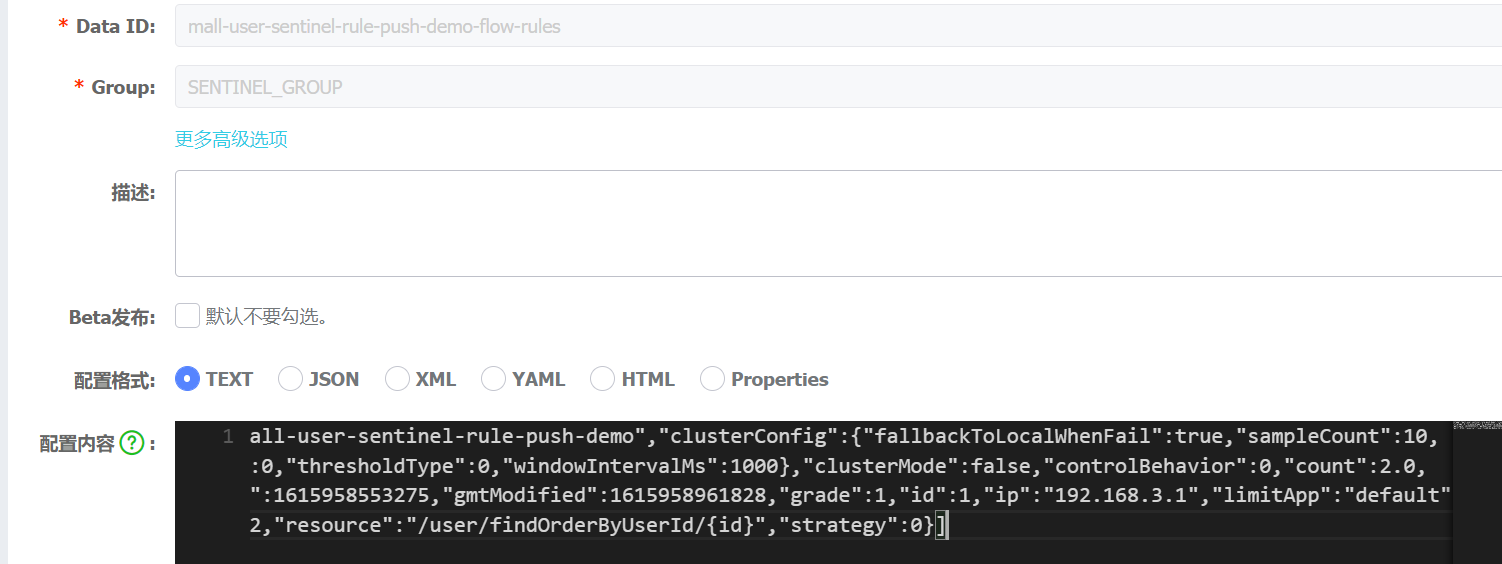
热点参数规则失效和解决思路
注意:控制台改造后有可能出现规则不生效的情况,比如热点参数规则因为Converter解析json错误的原因会导致不生效。
参见源码:com.alibaba.csp.sentinel.datasource.AbstractDataSource#loadConfig(S) 会解析配置规则。
原因是:改造dashboard,提交到nacos配置中心的数据是ParamFlowRuleEntity类型,微服务拉取配置要解析的是ParamFlowRule类型,会导致规则解析丢失数据,造成热点规则不生效。 其他的规则原理也是一样,存在失效的风险。
nacos配置中心保存的数据格式:
[{ "app": "mall-user-sentinel-rule-push-demo", "gmtCreate": 1616136838785, "gmtModified": 1616136838785, "id": 1, "ip": "192.168.3.1", "port": 8719, "rule": { "burstCount": 0, "clusterConfig": { "fallbackToLocalWhenFail": true, "sampleCount": 10, "thresholdType": 0, "windowIntervalMs": 1000 }, "clusterMode": false, "controlBehavior": 0, "count": 1.0, "durationInSec": 1, "grade": 1, "limitApp": "default", "maxQueueingTimeMs": 0, "paramFlowItemList": [], "paramIdx": 1, "resource": "hot" } }, { "app": "mall-user-sentinel-rule-push-demo", "gmtCreate": 1616137178470, "gmtModified": 1616658923519, "id": 2, "ip": "192.168.3.1", "port": 8719, "rule": { "burstCount": 0, "clusterConfig": { "fallbackToLocalWhenFail": true, "sampleCount": 10, "thresholdType": 0, "windowIntervalMs": 1000 }, "clusterMode": false, "controlBehavior": 0, "count": 3.0, "durationInSec": 1, "grade": 1, "limitApp": "default", "maxQueueingTimeMs": 0, "paramFlowItemList": [{ "classType": "int", "count": 1, "object": "4" }], "paramIdx": 0, "resource": "findOrderByUserId" } }]
我提供两种解决思路:
- 自定义一个解析热点规则配置的解析器FlowParamJsonConverter,继承JsonConverter,重写convert方法。然后利用后置处理器替换beanName为"param-flow-rules-sentinel-nacos-datasource"的converter属性,注入FlowParamJsonConverter。
@Configuration public class ConverterConfig { @Bean("sentinel-json-param-flow-converter2") @Primary public JsonConverter jsonParamFlowConverter() { return new FlowParamJsonConverter(new ObjectMapper(), ParamFlowRule.class); } } @Component public class FlowParamConverterBeanPostProcessor implements BeanPostProcessor { @Autowired private JsonConverter jsonParamFlowConverter; @Override public Object postProcessBeforeInitialization(Object bean, String beanName) throws BeansException { if (beanName.equals("param-flow-rules-sentinel-nacos-datasource")) { NacosDataSourceFactoryBean nacosDataSourceFactoryBean = (NacosDataSourceFactoryBean) bean; nacosDataSourceFactoryBean.setConverter(jsonParamFlowConverter); return bean; } return bean; } } public class FlowParamJsonConverter extends JsonConverter { Class ruleClass; public FlowParamJsonConverter(ObjectMapper objectMapper, Class ruleClass) { super(objectMapper, ruleClass); this.ruleClass = ruleClass; } @Override public Collection<Object> convert(String source) { List<Object> list = new ArrayList<>(); JSONArray jsonArray = JSON.parseArray(source); for (int i = 0; i < jsonArray.size(); i++) { //解析rule属性 JSONObject jsonObject = (JSONObject) jsonArray.getJSONObject(i).get("rule"); Object object = JSON.toJavaObject(jsonObject, ruleClass); list.add(object); } return list; } }
- 改造Sentinel Dashboard控制台,发布配置时将ParamFlowRuleEntity转成ParamFlowRule类型,再发布到Nacos配置中心。从配置中心拉取配置后将ParamFlowRule转成ParamFlowRuleEntity。
从配置中心拉取配置到控制台时,FlowRule转换为FlowRuleEntity
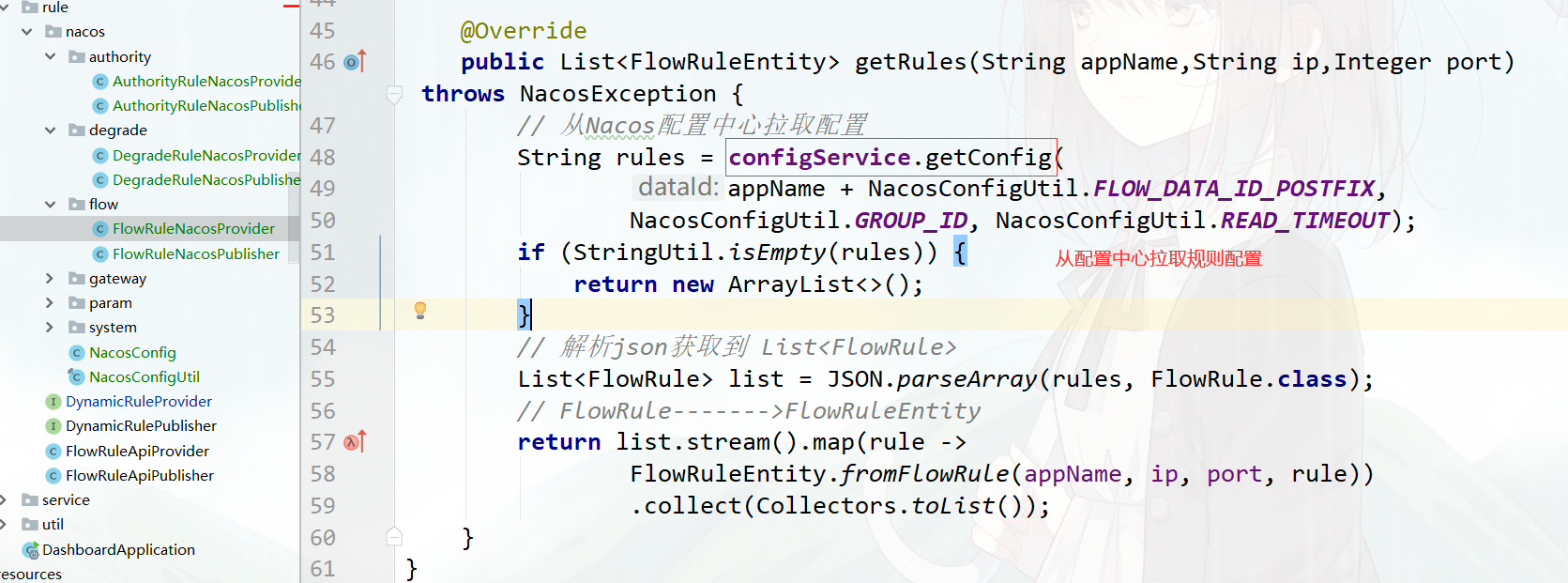
从控制台发布配置到配置中心时,FlowRuleEntity转换为FlowRule
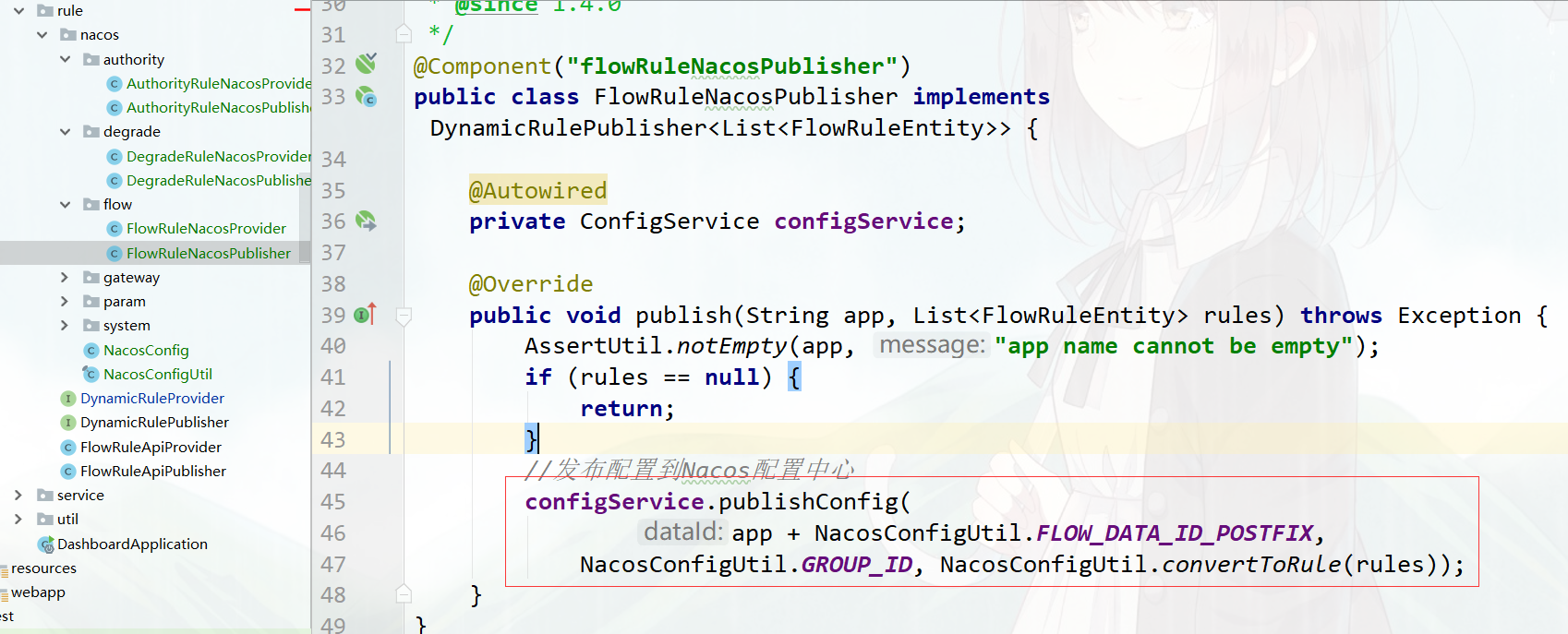
2. sentinel规则持久化部分源码分析
https://www.processon.com/view/link/62e24778e0b34d06e56ab4b9
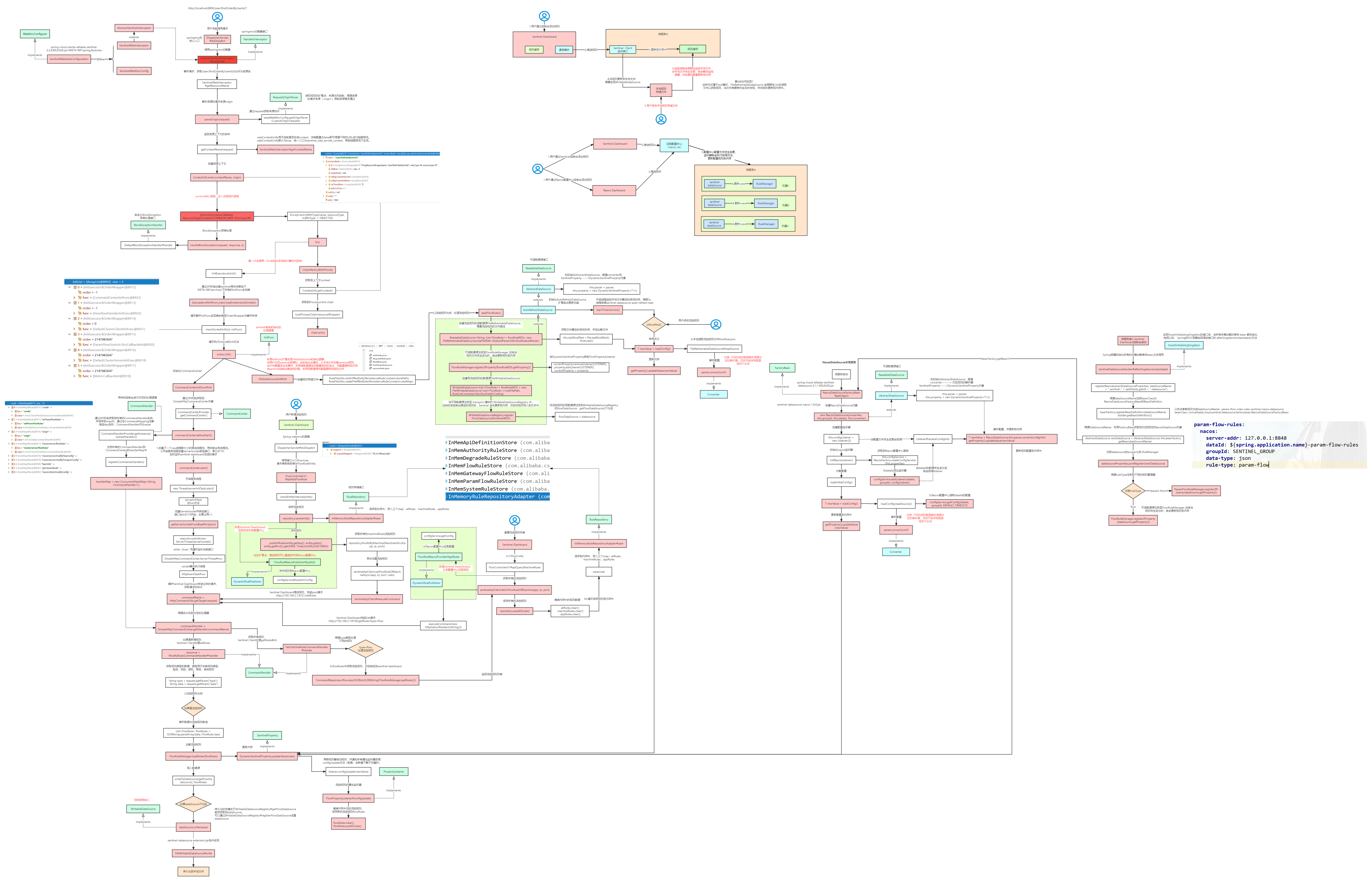





【推荐】编程新体验,更懂你的AI,立即体验豆包MarsCode编程助手
【推荐】凌霞软件回馈社区,博客园 & 1Panel & Halo 联合会员上线
【推荐】抖音旗下AI助手豆包,你的智能百科全书,全免费不限次数
【推荐】博客园社区专享云产品让利特惠,阿里云新客6.5折上折
【推荐】轻量又高性能的 SSH 工具 IShell:AI 加持,快人一步
· 微软正式发布.NET 10 Preview 1:开启下一代开发框架新篇章
· 没有源码,如何修改代码逻辑?
· PowerShell开发游戏 · 打蜜蜂
· 在鹅厂做java开发是什么体验
· WPF到Web的无缝过渡:英雄联盟客户端的OpenSilver迁移实战